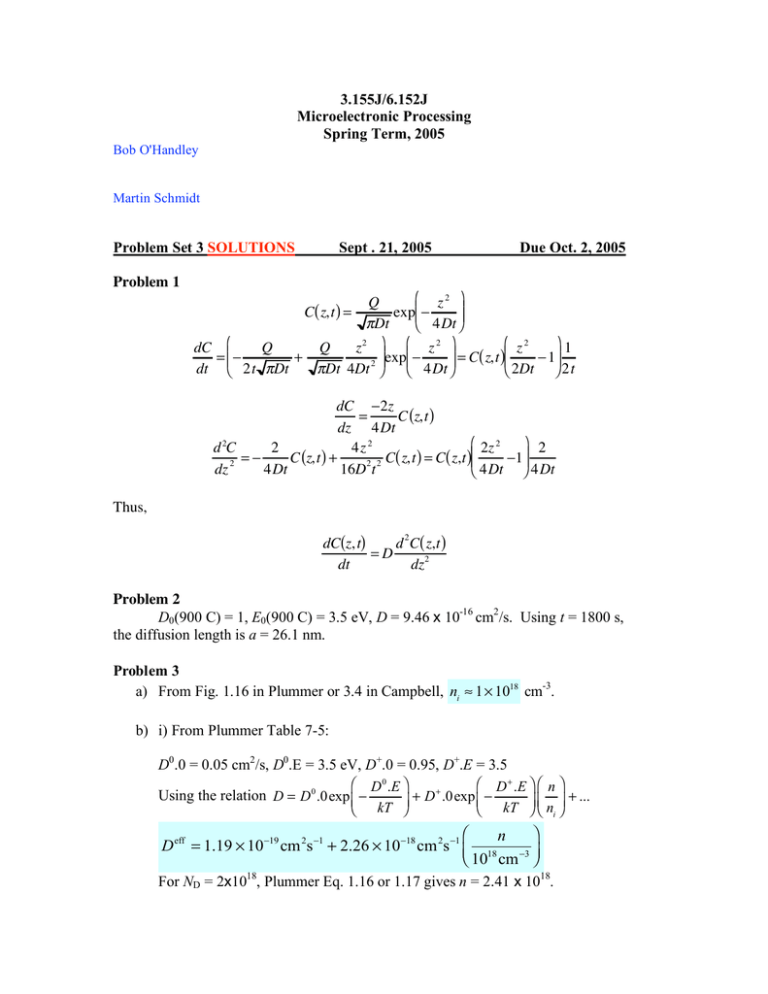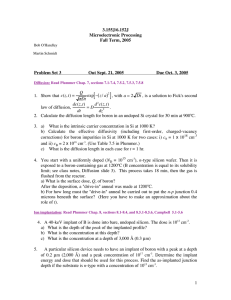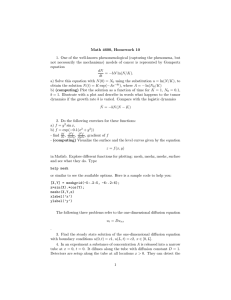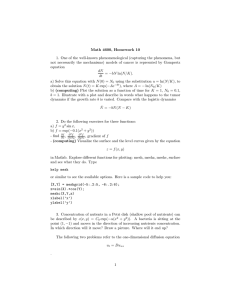3.155J/6.152J Microelectronic Processing Spring Term, 2005 Problem Set 3
advertisement

3.155J/6.152J Microelectronic Processing Spring Term, 2005 Bob O'Handley Martin Schmidt Problem Set 3 SOLUTIONS Problem 1 Sept . 21, 2005 Due Oct. 2, 2005 # z2 & Q (( C( z,t ) = exp%% " !Dt $ 4Dt ' # z2 &1 dC #% Q Q z2 &( #% z 2 &( = %! + = C( z,t )%% ! 1(( 2 ( exp% ! ( dt $ 2t "Dt "Dt 4Dt ' $ 4Dt ' $ 2Dt ' 2t dC !2z = C (z,t ) dz 4Dt " 2z 2 % 2 d 2C 2 4z 2 =! C (z,t ) + C( z,t ) = C( z,t )$$ !1'' dz 2 4Dt 16D2 t 2 # 4Dt & 4Dt Thus, dC(z, t) d 2 C( z,t ) =D dt dz2 Problem 2 D0(900 C) = 1, E0(900 C) = 3.5 eV, D = 9.46 x 10-16 cm2/s. Using t = 1800 s, the diffusion length is a = 26.1 nm. Problem 3 a) From Fig. 1.16 in Plummer or 3.4 in Campbell, ni ! 1 " 1018 cm-3. b) i) From Plummer Table 7-5: D0.0 = 0.05 cm2/s, D0.E = 3.5 eV, D+.0 = 0.95, D+.E = 3.5 " D 0 .E % " D + .E % " n % + Using the relation D = D 0 .0exp $ ! + D .0exp ' $ ! kT ' $ n ' + ... # kT & # &# i& # & n D eff = 1.19 ! 10"19 cm 2s "1 + 2.26 ! 10"18 cm 2s "1 % 18 "3 ( $ 10 cm ' For ND = 2x1018, Plummer Eq. 1.16 or 1.17 gives n = 2.41 x 1018. Then Deff = 1.19 x 10-19 + 5.46 x 10-18 = 5.57 x 10-18 cm2/s. For ND = 1x1018, n = 1.62 x 1018. Then Deff = 1.19 x 10-19 + 3.66 x 10-18 = 3.78 x 10-18 cm2/s. c) Diffusion lengths in the two cases are a = 2 Dt = 2.83 nm and 2.33 nm, respectively. Problem 4 a) The idea of this failed problem was to calculate the dose of a dopant diffused into a substrate under high, constant external concentration conditions so that the diffusion constant is clearly dependent on depth. (One could only get the exact c(x) profile by numerical integration of the diffusion equation.) b) This part was aimed at probing your realization that now the boundary conditions had changed and the diffusion was done from a constant dose (erfc solution). If the numbers had been more carefully selected, you could have assumed that the junction depth would increase with time as (Dt)1/2 or inverted the solution c(z) c0 ≈ 5 × 1020 cm3 z c(z) c0 ≈ 5 × 1020 cm-3 c0 ≈ 7 × 1020 cm-3 z " z2 % " z2 % Q 15 !3 C z,t = Cs exp $ ! = exp ' $ ! 4Dt ' = N A = 10 cm 4Dt # & # & ( Dt ( ) to solve for the time required to put the junction at the desired depth. But this is not easily solved for t unless you first work under the assumption that the exponential time dependence dominates and start with, say t = 10 s in the preexponential factor (then iterate). This approach is also flawed by assuming that the solution can be arrived at analytically, even c(z) c0 if you chose the diffusion constant at the background dopant concentration. Clearly, the c0 new greater diffusion rate closer to the surface, Concentration enhanced where the impurity concentration is greater, would square-up the diffusion profile (see z sketch, dotted line) and accelerate the diffusion at greater depth, moving the estimated junction deeper, or the time to achieve a given depth, overestimated. Problem 5 a) At 40 keV, boron from Fig. 8-3, Rp ≈ 145 nm and ΔRp ≈ 58 nm. b) Given Q= 1012 cm-2 and ΔRp above, Q = (2π)1/2ΔRpcp gives cp = 6.88 × 1016 cm-3. # x! R 2& p ( at x = 300 nm gives c(300) = 1.53 × 1015 cm-3. c) c x = c p exp % ! 2 % 2 " Rp ( $ ' ( () ) Problem 6 Given Rp = 0.2 µm (200 nm) demands an implant of boron at about 60 keV (Fig. 83). At this energy ΔRp ≈ 52.5 nm, so the dose giving a peak concentration of 1017 cm3 is easily calculated from Q = (2π)1/2ΔRpcp to be 1.3 × 1012 cm-2. For a background doping of 1015 cm-3, the junction depth before diffusion is given by inverting # x! R 2& p ( to get two junctions, one at xjct = 40.7 nm the other at c x = c p exp % ! % 2 " Rp2 ( $ ' 359 nm. () ( )





